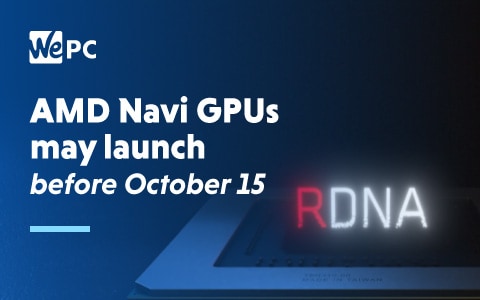In anticipation of a new batch of NAVI GPUs speculatively expected to release this October, reports of new cards joining AMD’s product line are popping up. Among these is the expectation that AMD will release a bevy of entry-level models to replace the Polaris 500-series, including a Radeon RX 5300 and Radeon RX 5500, alongside the existing high-end RDNA architecture-based RX 5700 launched during the summer.
The two rumored cards will ostensibly use Navi 12 and Navi 14 GPUs and tally up with the existing naming structure of the Ryzen 5300, 5500, 5700 – the number rising in line with the price point and performance of the GPU.
The naming is particularly insightful as it correlates with comments made by Radeon GM Scott Herkelman earlier this year. He said AMD would be adopting a more streamlined naming scheme moving forward to make it easier for users to recognize where a specific card sits in its generational hierarchy.
The plan is to keep this consistent across the next 5 to 10 year time period. The Radeon RX 5300 and RX 5500 names would fit into that new policy carrying over the nomenclature from the Ryzen series.
What We Know
Alongside the naming scheme, the RX 5300 was seen as part of a specification sheet for an HP build list earlier this year by ComputerBase, specifically as Radeon RX 5300 XT, while the RX 5500 was branded about in EEC registration documentation by GPU manufacturer Sapphire.
The RX 5300 is expected to boast 4 GB of GDDR 5 and use a Navi 14 chip with 24 CUs, placing it firmly within the budget range. The RX 5500, on the other hand, is presumed to use Navi 12 tech with somewhere between 32 and 36 CUs. No word on VRAM count, but anywhere up from 6 GB is a good bet.
If the rumors turn out to be correct, then next month should provide much-needed insight into AMD’s plans on the budget to mid-range front.


So, no 5000, 5200, 5400, or even-numbered nomenclatures at the front, eh? Okay, fine. It sounds like the ones for AMD to beat in the midrange GPU space are the Nvidia 1660/1660Ti and the upcoming 1660 “Super”. If AMD is going to continue with the “Rule of Two” GPU scheme, then they’re going to have to create two enhanced versions of the Vega 56 gpu (with the Navi architecture, of course) or a couple of 590s. Of course, one would need at least 8GB VRAM while the “XT” version should sport 12 GB VRAM, for starters. Also, one should have GDDR5 and the other with GDDR6. It goes without saying that AMD should up all the other specs while keeping them at 256-bits. If they can accomplish this while keeping the TDP at acceptable levels & the gpu prices lower than the 1660s, then AMD would be more than capable of fending off all 3 Nvidia cards. Of course, I’d much rather see AMD or one of their AIB partners start out with a dual-fan, open cooler for these “1660-killers” instead of the blower coolers. The 1650Ti isn’t really much of a factor, seeing as how the 1050 & 1650 were both outclassed by the RX 570. I’m aware that my description of the “1660-killers” would encroach upon and potentially cannibalize the RX 5700 GPUs since they would be so close to them in capabilities (but cheaper). I’m sure AMD could live with such a problem for a short duration, especially as they can always create a couple of “enhanced” 5700s with ray tracing included and release them in 2020, alongside whatever their “2080-killers” will be. I’m sure things won’t exactly go the way I’ve described, but it’s part of the fun of speculation.